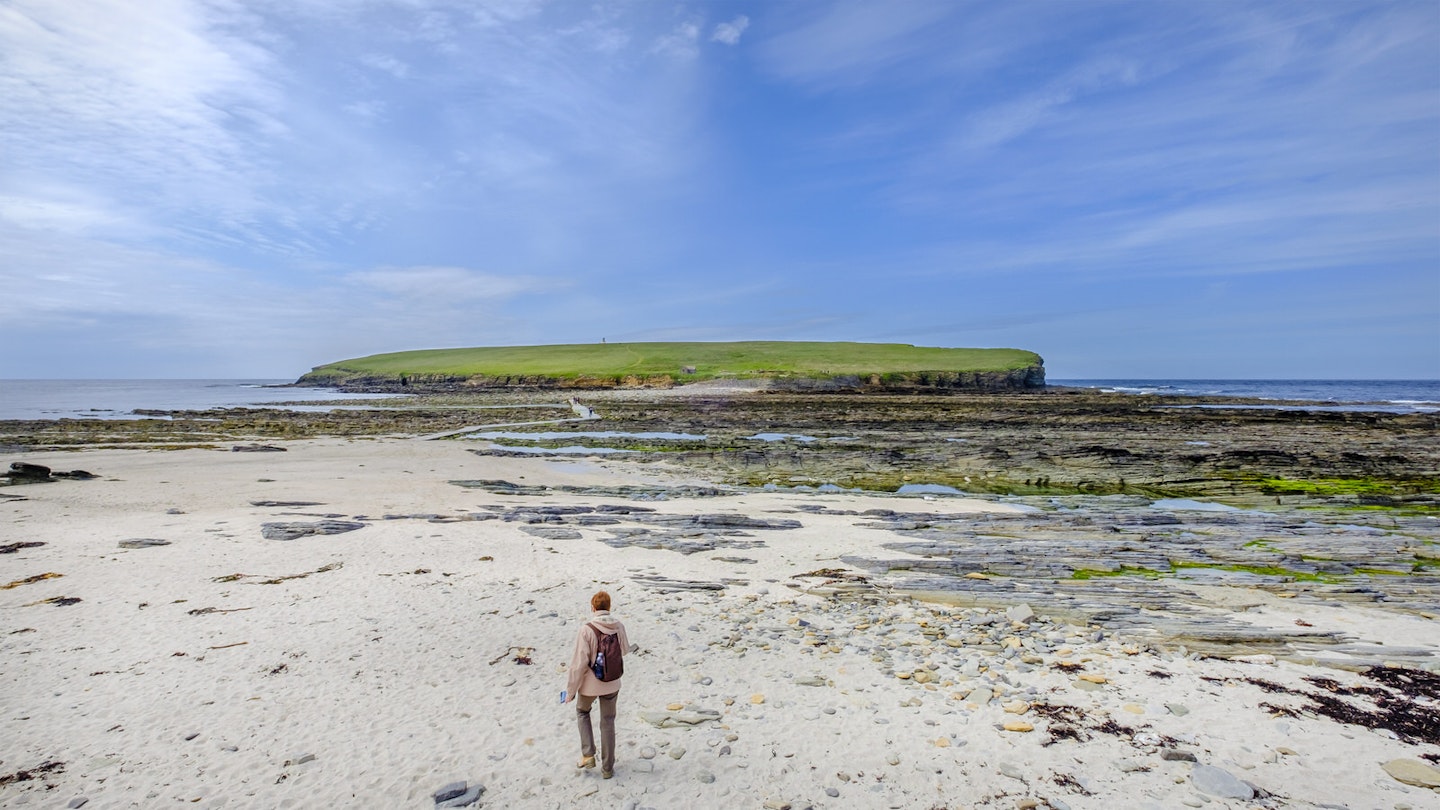Share
Jul 31, 2018 • 4 min read

Islands Accessible on Foot: Your Guide to Unique Coastal Walks
No boat? No problem. Here are eight islands you can reach on foot. Just lace up your shoes, wait for the tide to roll out, and voilà: pathways appear that lead to fairy-tale castles, religious shrines, Viking houses, and other exhilarating sights.
Brough of Birsay, Orkney, Scotland
A whole lot of history has unfolded on the desolate Brough of Birsay. In the 7th and 8th centuries, the tribal Picts staked a claim, and remnants of their settlement remain. Following them came the Norse, who left behind stunning Viking hall-houses from around the 10th century. The ruins of St Peter’s Church, which dates back to the 12th century, serve as a reminder that this Brough was once the seat of Orkney’s rulers. Clown-like puffins and sweeping, lighthouse-dotted cliffs add to the otherworldly atmosphere. An unforgettable visit to this ocean outcrop awaits, especially as you wait for the hazy concrete path to emerge from the tide and lead you across the water.

Noirmoutier, Brittany, France
For a few hours at low tide each day, the 4.5km Passage du Gois surfaces from the sea, connecting the village of Beauvoir-sur-Mer, on the mainland near Brittany, to the enchanting island of Noirmoutier. This idyllic place features whitewashed, blue-shuttered houses, vibrant hollyhocks, and sparkling salt pans. The island is also home to a medieval castle with a Michelin-starred restaurant. While you could make the trip on wheels, it becomes much more enjoyable on foot, allowing you to join locals as they search for cockles and clams in the exposed sand. However, be sure to pay attention to the tide times, or prepare to climb one of the safety poles placed at intervals along the passage to wait until the waters recede.

Jindo and Modo, South Korea
For a few days each year, typically in spring, the tide drops exceptionally low, revealing a 2.8km-long, 40m-wide causeway that connects the island of Jindo to the nearby island of Modo in the southwest corner of South Korea. Known as the Ganjuyuk Gyedo (Mysterious Sea Road), this path is celebrated among Koreans in lore. The Jindo Miracle Sea Road Festival takes place annually to coincide with the road’s emergence, drawing over 300,000 visitors who make the crossing in knee-high rubber boots.
Minister’s Island, New Brunswick, Canada
It always feels like magic: at low tide, you can stroll 1km across the ocean floor to reach Minister’s Island, only to watch the path vanish under several feet of water at high tide. The Reverend Samuel Andrews acquired the island in 1790 to tend to his parishioners, which is how it got its name; the stone cottage where he lived still stands today. Next, railway magnate William Cornelius Van Horne purchased the island in 1890, constructing a ‘cottage’ complete with 50 rooms, 17 bedrooms, 11 fireplaces, and a windmill to provide running water. Exploring this area transports you to a bygone era of Edwardian opulence.

Haji Ali Dargah, Mumbai, India
Here’s the legend of the Dargah, a Sufi shrine located on an islet beside Mumbai: The Muslim saint Pir Haji Ali Shah Bukhari, a performer of miracles and a teacher of Islam in the mid-15th century, died during his pilgrimage to Mecca. His shroud mysteriously floated back to this speck of land, leading his followers to construct a white marble mosque on the spot to honor him. For much of the day, it shimmers like a mirage out at sea. However, when the tide recedes, a causeway emerges, allowing devotees to walk to the holy site — a pilgrimage they make in droves, especially on Fridays, when Sufi singers fill the air with their harmonious melodies.
Bar Island, Maine, USA
This part-time island floats just offshore from the picturesque village of Bar Harbor. At low tide, make your way to the foot of Bridge St to discover a natural gravel land bridge that materializes from the water. It’s a 1.5km walk to the islet, where you can explore the forest, meadows, and rocky shoreline. A trail leads up to a small peak that offers stunning views of the surrounding sea and mountains. The postcard-perfect scenery is no surprise, as the island is part of Acadia National Park, renowned for its breathtaking coastal landscapes.

Lindisfarne, Northumberland, England
A stone’s throw from the Scottish border, the Holy Island of Lindisfarne remains as remote and windswept as when St Aidan stepped ashore to establish his monastery here in 635. Twice a day, the tides shift, revealing a path that leads through the sand and mudflats. Known as the Pilgrim’s Way, this route has been used for centuries to make the trek to this small isle. A line of vertical poles marks the 5km path, rewarding those who dare to make the journey with ancient abbey ruins to explore, a commanding hilltop castle to climb, and a bird reserve home to merlins and bar-tailed godwits.
Mandø, Denmark
The serene Mandø lies in the Wadden Sea near the west coast town of Ribe. When you visit this secluded little island, you’ll likely find yourself in the company of grazing sheep and the gentle rustling of the grass, joined by around 60 villagers under the expansive slate-blue sky. Although accessing Mandø on foot is theoretically possible via the causeway that emerges at low tide, most people opt for the tractor-pulled bus that navigates the muddy path until the water returns, floating the island once again.





